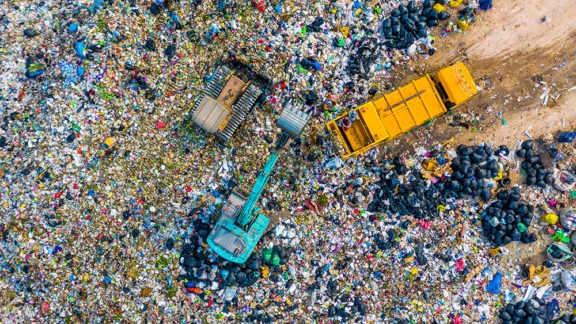What to know: California’s climate-disclosure regulations take effect soon. These regulations require certain entities to disclose greenhouse gas emissions as well as climate-related risks and mitigation measures. Now is the time to prepare for compliance and for future organizational resilience and sustainability.
On Jan. 1, 2026, the first climate-risk-disclosure reports will be due under a new set of California laws that aim to bring more transparency and accountability to corporate environmental practices. As this key deadline approaches — marking a transformative shift in climate-related reporting — many organizations are looking for guidance on their obligations and risks.
Clearly, companies need to understand California’s climate-disclosure regulations so that they can comply. But preparing for these regulations also presents a broader opportunity to prepare for a future in which managing climate-related risks — and transparency about and accountability for those risks — is essential to doing business. A strategic approach now can set the foundation for a more resilient and sustainable company future.
What are California’s climate-disclosure regulations?
Senate Bill (SB) 253, SB 261, and SB 219 (Health & Safety Code §§38532-38533) — collectively referred to as “the 200s” by the California Air Resources Board (CARB), which has the responsibility to implement and enforce them — establish distinct but complementary requirements for large organizations operating in California. Broadly, these bills aim to support California in achieving its climate-related objectives and to allow the public and investors to evaluate environmental impacts more efficiently.
Here’s a high-level look at the main disclosure laws, SB 253: Climate Corporate Data Accountability Act and SB 261: Climate-Related Financial Risk Act:
| SB 253 | SB 261 | |
| Affected entities | Those “doing business in California”* with annual revenues >$1B. | Those “doing business in California”* with annual revenues >$500M. |
| Reporting requirements | Company-wide annual Scope 1 and 2 greenhouse gas (GHG) emissions starting in 2026; Scope 3 starting in 2027, with phased-in assurance requirements. | Biennial disclosure of company-wide climate-related risks and mitigation measures. |
| Proposed annual reporting fee estimate | $3,106 | $1,403 |
| Reporting deadlines | Disclose by June 30, 2026, and annually thereafter. | Disclose by Jan. 1, 2026, and biennially thereafter. |
| Methodology | Greenhouse Gas Protocol SB253_Draft_Scope1_2_GHG_Template.xlsx | Align with Task Force on Climate-Related Financial Disclosures (TCFD), International Financial Reporting Standards (IFRS) S2, or equivalent. |
| Assurance requirements | Third-party assurance required: limited (2026), reasonable (2030). | No assurance required. |
SB 219: Amendments
While not a stand-alone disclosure law, SB 219 applies to entities covered under both SB 253 and SB 251 and amends the rules, including by extending CARB’s rulemaking deadline, allowing consolidated reporting at the parent-company level, and introducing a phased approach to Scope 3 reporting.
Notably, CARB has not yet adopted final implementing regulations for these laws and recently proposed an updated timeline further delaying final rulemaking until the first quarter of 2026. Nevertheless, the looming Jan. 1, 2026, statutory deadline for entities to begin complying with these laws remains unchanged, requiring initial disclosures to be submitted before the final rules are adopted. The final rulemaking will include clarity on definitions needed for determining which entities are covered, such as “revenue,” “doing business in California,” and “parent-subsidiary” relationships, as well as for finalizing the framework for reporting and fee regulation. Companies should prepare to comply despite this regulatory uncertainty.
Who needs to comply?
As noted above, some of the parameters for coverage are still not fully defined. But we know that companies across industries will be impacted: essentially, any entity that meets the thresholds above. CARB published a Preliminary List of Reporting/Covered Entities in September 2025, cautioning that this list should not be considered complete. Unfortunately, coverage will depend on the company’s circumstances and not yet finalized regulatory definitions.
CARB has already offered some guidance on proposed exemptions:
- Insurance companies regulated by the California Department of Insurance or engaged in the business of insurance in any other state are exempt.
- Subsidiaries covered by consolidated parent-company financial risk reports are exempt from separate reporting.
- CARB staff have proposed exempting nonprofit organizations, based on stakeholder feedback.
- Exemption has also been proposed for entities whose only business activity in California is the presence of teleworking employees.
- Governmental and public entities are not considered business entities under the statue and do not require a formal exemption.
- Electronic transmission and interstate power delivery providers — specifically, CAISOs (California independent system operators) and entities whose only activity consists of wholesale electricity transactions in interstate commerce — are proposed for exemption.

How can you prepare?
Organizations can still prepare now to both comply with California’s climate-disclosure laws and create a strong foundation for future corporate sustainability reporting. Beyond potential financial penalties for noncompliance, an organization’s reputation and investor confidence could be at risk.
Preparation for such sweeping financial and environmental data disclosure can seem daunting. Organizations can start or move forward with a few targeted steps.
Assemble your team and your data: A cross-functional team can help organize financial data and emissions information as well as identify where gaps in your data exist — essential for showing a good faith effort to comply, which the CARB requires for incomplete reporting. A team that involves representatives from the finance, legal, risk management, operations, and sustainability departments can forge a clear picture of an organization’s data.
Understand reporting frameworks: The CARB requires disclosure in alignment with GHG Protocol for SB 253. Likewise, it requires disclosure in alignment with TCFD, IFRS S2, or an equivalent for SB 261. Organizations can prepare to align their reporting with these standards and use them to identify where any gaps may arise. Final, public reports must either satisfy all requirements or explain gaps and plans to address them. If you already file substantially similar climate-related disclosures, you may be able to leverage those reports.
Understand assurance requirements: Organizations that need to comply with SB 253 will also need to leave time to secure third-party assurance of their disclosures. Limited assurance (also often called negative assurance) — required by June 2026 — requires an independent auditor to obtain “sufficient and appropriate evidence” to conclude that “nothing came to their attention” that would indicate the sustainability information subject to assurance was materially misstated. To collect that evidence, the assurance provider may interview management, analyze company data, and understand internal controls for data collection. The more stringent standard of reasonable assurance (also called positive assurance) will be required by 2030.
Track key compliance milestones:
- Jan. 1, 2026: The first climate-risk-disclosure reports are due. The CARB will provide a public docket open Dec. 1, 2025, through July 1, 2026, for entities to post the public link to their reports.
- June 30, 2026: First SB 253 Scope 1 and 2 GHG emissions report due (with limited assurance).
- 2027: First SB 253 Scope 3 emissions report due.
- 2030: Reasonable assurance for Scope 1 and 2, limited assurance for Scope 3 required.
CARB has held two public workshops and posted some limited guidance to help entities prepare:
- California Corporate Greenhouse Gas (GHG) Reporting and Climate Related Financial Risk Disclosure Programs
- California Corporate Greenhouse Gas Reporting and Climate-Related Financial Risk Disclosure Programs: Frequently Asked Questions Related to Regulatory Development and Initial Reports (posted July 9, 2025)
- Climate Related Financial Risk Disclosures: Draft Checklist (posted Sept. 2, 2025)
- SB 253 Scope 1 and Scope 2 Greenhouse Gas (GHG) Emissions Draft Reporting Template (posted Oct. 10, 2025)
Deadlines are quickly approaching, so if you are not yet prepared, now is the time to take action.
We know that many entities have just begun their California climate compliance journey. Our Haley & Aldrich team provides end-to-end support for California climate disclosure compliance, drawing on experience from across industries that range from industrial and manufacturing to real estate development to construction. We can help navigate complexity, reduce risk, and unlock the strategic value of transparent climate reporting to the delivery of credible, defensible disclosures aligned with long-term business goals.
Published: 11/5/2025
- Aerospace
- Education, healthcare, and cultural institutions
- Industrial and manufacturing
- Real estate developers
- Sustainability
- Disaster and climate resilience services
Authors

Senior Sustainability Strategy Advisor

Senior Associate, Climate Resilience Specialist




